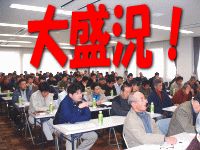AKAIKA and Marrying Off A Daughter

Hello. My name is Hiroiwa. I am a fisherman mainly performing the small craft net-fishing and the AKAIKA bowie fishing in Tottori Prefecture.
Entitling this report "the measure for the improvement in an AKAIKA unit price", I would like to introduce activities of our Tottori AKAIKA study group. "AKAIKA" we talk about here is properly known as "SODEIKA". In Tottori and Hyogo, "SODEIKA" is called "AKAIKA." The average fish catch of Tottori Prefecture in the past four years is 481t per year. It is the 3rd-place gross receipt following Okinawa and Hyogo.
AKAIKA(SODEIKA): Thysanoteuthis rhombus Troschel, 1857
The motive of research and subject selection
Now I would like to explain the circumstances of the study group inauguration.
 During the decrease of fish resources in the coast fishery, only the AKAIKA fishery operated in August through December decreased in number of bumper fish crop continuation in recent years, and was just the inshore fishermen's white hope. AKAIKA once used to be bid off at the high price of the kilo of 1500 yen or more. However, this bumper fish crop has brought the fell of unit price of AKAIKA.
During the decrease of fish resources in the coast fishery, only the AKAIKA fishery operated in August through December decreased in number of bumper fish crop continuation in recent years, and was just the inshore fishermen's white hope. AKAIKA once used to be bid off at the high price of the kilo of 1500 yen or more. However, this bumper fish crop has brought the fell of unit price of AKAIKA.
It is a tough situation when the 350 yen/kg breaks. In the Heisei 13 fiscal year, the price had already become the level of 200 yen/kg before October. When the price goes down like this, even a fishing adjustment is nothing but a drop in the bucket. How far will it really fall? At the auction on November 22, the price finally dropped at 100 yen/kg. That's the AKAIKA Slump. The tear came out in a frustration imagining of how I would feel about giving a daughter in marriage and she is unexpectedly treated at the point like AKAIKA after the marriage -- I would probably feel the same way.
 I brought an actual product today. This AKAIKA is 7kg. In the auction value of the kilo of 100 yen, the price of this AKAIKA will be 700 yen. A box for this AKAIKA costs about 300 yen. The pure profit from this AKAIKA would be 400 yen. This is an exploitation or what? It is maddening. At the same time AKAIKA was given the cold shoulder by the consumer. We were very concerned about the future of our AKAIKA fishing.
I brought an actual product today. This AKAIKA is 7kg. In the auction value of the kilo of 100 yen, the price of this AKAIKA will be 700 yen. A box for this AKAIKA costs about 300 yen. The pure profit from this AKAIKA would be 400 yen. This is an exploitation or what? It is maddening. At the same time AKAIKA was given the cold shoulder by the consumer. We were very concerned about the future of our AKAIKA fishing.
Meanwhile, we invited volunteers and opened a shop at a local event. We provided baked AKAIKA, AKAIKA tempura, boiled Japanese radish with flavors, and fresh fish for sale. There were a lot more people than we anticipated stopped by and purchased what we had. This successing result of vending determined our direction.
AKAIKA appeared in local supermarkets and mass marchandisers in these two to three years. Before that AKAIKA was shipped outside Tottori at a high price, and was not familiar to the local consumers. In such meaning AKAIKA is new food to most consumers. Because AKAIKA is very thick, but also very soft, it should suit many types of consumers' needs which we were sure of from the past vending experience. We also realized that we the fishermen must participate, think, and act while crying over the slump in this tendency.
We had a sense of impending crisis in sudden fall of the AKAIKA unit price. We called for being united and working together to all AKAIKA fishery companies within the prefecture.

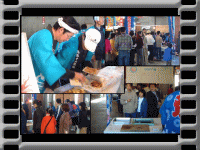
The Tottori AKAIKA Study Group inauguration
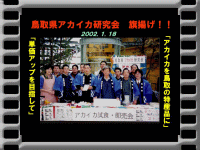 And the Tottori AKAIKA Study Group was inaugurated in January, Heisei 14 with great expectation of fishery companies. The producers of this single fish called AKAIKA became organized on one theme called a unit price rise on a scale of whole prefecture. (This is the beginning of the "Project X" of the fishermen.) I would like to explain the major activities and their results.
And the Tottori AKAIKA Study Group was inaugurated in January, Heisei 14 with great expectation of fishery companies. The producers of this single fish called AKAIKA became organized on one theme called a unit price rise on a scale of whole prefecture. (This is the beginning of the "Project X" of the fishermen.) I would like to explain the major activities and their results.
Research / practical activity situation and result
 We showed up at various events as much as possible. We first started letting consumers know how to prepare and eat AKAIKA through food tasting and sale.
We showed up at various events as much as possible. We first started letting consumers know how to prepare and eat AKAIKA through food tasting and sale.
With the female section members of the fisheries cooperative association, we held meetings with consumers and worked on a development of new AKAIKA dishes creating cooking recipes to familiarize AKAIKA as a food material.
Providing AKAIKA for a school lunch material is one of the biggest targets of our activity. We took off the trouser-raincoats and put aprons on, and went to schools for AKAIKA sampling parties and presentations.
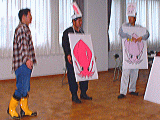

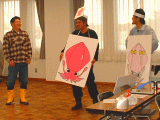
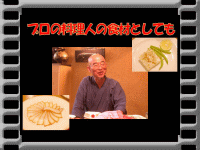 Parallel to these activities, we actively promoted AKAIKA to the hotel associations and restaurant-related parties. We had an opportunity to have a chef use AKAIKA and provide several AKAIKA menus at his restaurant. This has turned out to make a more effective appeal of this unique food as a new taste of Tottori.
Parallel to these activities, we actively promoted AKAIKA to the hotel associations and restaurant-related parties. We had an opportunity to have a chef use AKAIKA and provide several AKAIKA menus at his restaurant. This has turned out to make a more effective appeal of this unique food as a new taste of Tottori.
The next opportunity was given while the global event, 2002 FIFA World Cup Korea Japan as Tottori city provided a camp ground for the Ecuador team. This huge AKAIKA was picked up for one of the welcome reception menus representing the local food, then gradually AKAIKA attracted people's attention as a food material.
During the best AKAIKA fishing season in last autumn, there was the National Cultural Festival in Tottori. It goes without saying that that made a very good opportunity to let the participants and visitors from out of Tottori know AKAIKA.
On another front, a brainchild of the AKAIKA Processing and Sales Promotion Cooperation which is one of the auxiliary projects of National Federation of Fisheries Cooperative Associations, AKAIKA frozen blocks with vacuum sealing became available. Thereby, safer handling and more stable supply year around were established.
In last December, AKAIKA was introduced for the first time into the lunch supply of one public nursery school on a trial basis. Favorable notice was left and in January, AKAIKA appeared in lunch menus of all public nursery schools in Tottori city.
AKAIKA is a good meal material not only for nursery schoolers, but also for elderly people with aged tooth conditions. Homes for elderly people opened up a new demand. AKAIKA is so soft and can be easily bitten off in any direction while tasting its flavor. AKAKIKA would suit the needs of Japan's rapid aging population.
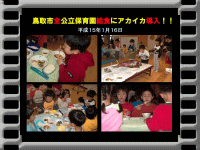
We held an AKAIKA cooking workshop intended for nutritionists aiming at entrenching AKAIKA in all lunch supply industries. That more nutritionists applied for the workshop than the actual available seats is, we think, the sign of growing interest in AKAIKA at their work front.
There was a prefecture and board-of-education-sponsored forum "Protect children's food and health by producing and consuming locally" in February. The Tottori governor Katayama hosted the forum and a nutritionist who had been in charge of introducing AKAIKA into the lunch supply for public nursery schools presented the circumstances of the process. During their deep conversation about the topic of this forum, the word "AKAIKA" was used numerous times by them. I think many people felt good about it including myself.
There has been a seldom use of ear portions of AKAIKA. We provided dumplings made of AKAIKA ear portions for food sampling at this forum. An increase of ear portions and foot portions of AKAIKA will be conductive to the unit price rise.
 On top of the food sampling, we also showed off the AKAIKA dancing song in front of the audience of 2,000 for the first time. NOW OR NEVER!
On top of the food sampling, we also showed off the AKAIKA dancing song in front of the audience of 2,000 for the first time. NOW OR NEVER!
In March 1, we had a meeting with Tottori co-op and shared our activity
report. The co-op partners expressed high interest in AKAIKA and an AKAIKA
product development. AKAIKA became a considerable food material for the
consumer.
Ripple effect
Those various activities of Tottori AKAIKA Study Group got into the media as producer information from the fishemen, and AKAIKA has been recognized espaecially in the local area. I would like to list the result of the activities numerically.
Compared to the Heisei 13 fiscal year, the average unit price of Tottori central fisheries cooperative association in the Heisei 14 fiscal year gained a little more than 100 yen/kg. It would be precipitant to say that this price rise has been brought by only our efforts as a decrease of AKAIKA fish catch may have affected, but still we believe that the activities of our study group brought a hight proportion of this situation considering the significant increase of consumption of the small size of two sets and three sets which are relatively easy to handle at a home. Especially in October, the unit price of two AKAIKAs rose above 130 yen/kg and the unit rice of three AKAIKAs rose above 170 yen/kg compared to Heisei 13. The growth of local consumption has definitely kept the unit price stable.
Avobe all, the presence of fishermen got recognized as well as AKAIKA through the activities. We received e-mails from junior high school students who are interested in becoming fishermen, and a local high school created a web site of Tottori AKAIKA Study Group for us as one of their class activities.
 We also made a music CD of AKAIKA called "The Original AKAIKA Dancing Song". Songwriting is by a third-year student of a local high school. As previously mentioned about having shown off the performance at the forum, we found the rehearsal with the performers and staffs was nothing but fun. It is noteworthy that this series of our ctivities brought a big meaning to activation of the local area.
We also made a music CD of AKAIKA called "The Original AKAIKA Dancing Song". Songwriting is by a third-year student of a local high school. As previously mentioned about having shown off the performance at the forum, we found the rehearsal with the performers and staffs was nothing but fun. It is noteworthy that this series of our ctivities brought a big meaning to activation of the local area.
I lastly would like to talk about the possible future subjects and plans. It has been an eventful period of 16 months for us since the AKAIKA slump pricing 100 yen/kg at the auction on November 22, Heisei 13 springing back stronger from he bitter tears for AKAIKA. AS a result of out efforts, AKAIKA has been made better known and its familiarity is going up with the evidence of growing consumption of handy small size AKAIKA.
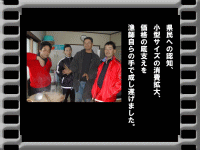
However, large size AKAIKA mainly shipped outside Tottori is still growing sluggishly in the nationwide market circulation rate. It used be sold at a high price and sedactive for AKAIKA fisheries. The real challenge for the improvemrnt in the AKAIKA unit price we have started is to establish a nationwide selling strategy.
The Tottori AKAIKA Study Group strives to start-up another study group on a nationwide scale by calling for prefectures of AKAIKA production. Our enthusiastic activities will continue to hold the first National AKAIKA summit conference next year of 2004 in Tottori.
Thank you for reading to the last.


